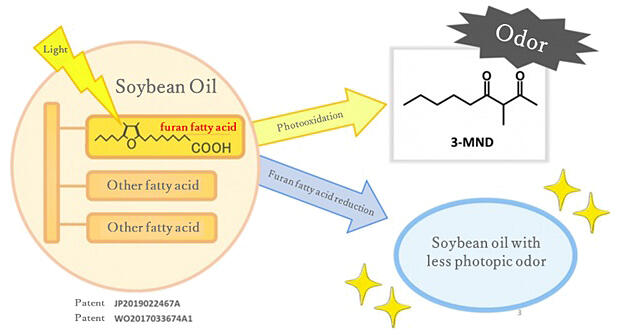Meat substitutes made from soybeans are gaining popularity. However, the problem is that when soybean oil is exposed to light, the furan acid in the oil decomposes to produce 3-methyl-2,4-nonanedione (3MND), and an unpleasant dry grass-like odor, called "photopic odor," is released. The research group led by Professor Toyoaki Anai of the Faculty of Agriculture at Kyushu University, Associate Professor Satoshi Watanabe of the Faculty of Agriculture at Saga University and J-Oil Mills Inc. discovered a soybean mutant whose oil barely contains furan acid. For the first time in the world, they succeeded in identifying the genes that participate in furan acid synthesis. The mutant genes that reduce the content of furan acid can be used to develop soybeans with less photopic odor and also to produce new soybean varieties with increased value as oil crops. The results were published online in The Plant Journal.

Provided by Kyushu University
The research group has been rigorously searching for soybean variants, with low furan acid content, from among hundreds of available species. However, they failed to identify any soybean breed that fit this criteria. Following this, they searched the soybean mutant resource developed by Anai and recognized four mutant lines, whose maximum furan acid contents were less than one-tenth of that observed in the normal breed. They successfully identified two causative genes in these mutants. In addition, they prepared soybean oil from the mutant line containing a low concentration of furan acid and evaluated the oxidation stability and generation of unpleasant odor. The results of this indicated that compared to the oil produced from the standard soybean breed of Fukuyutaka, the oil prepared from the mutant line had high oxidation stability and a suppressed level of unpleasant odor.
Unpleasant odors derived from soybean oil are known to arise from linoleic acid, the sour odor of oxidized α-linolenic acid, and the grassy odor of linoleic acid decomposed by enzymes (lipoxygenase). Anai's group had previously succeeded in breeding soybean, whose oil had a high oleic-acid content. A high oleic-acid content eliminates the rancid and grassy smells. By combining the research results with the high oleic-acid trait, new soybean varieties producing oils that is rich in oleic acid and barely contains furan acid could be engineered. The combined varieties are expected to show higher oxidation stability and significantly reduce unpleasant odors caused by deterioration compared to the standard breed, thereby solving the problem specific to the soybean oil.
This article has been translated by JST with permission from The Science News Ltd. (https://sci-news.co.jp/). Unauthorized reproduction of the article and photographs is prohibited.




